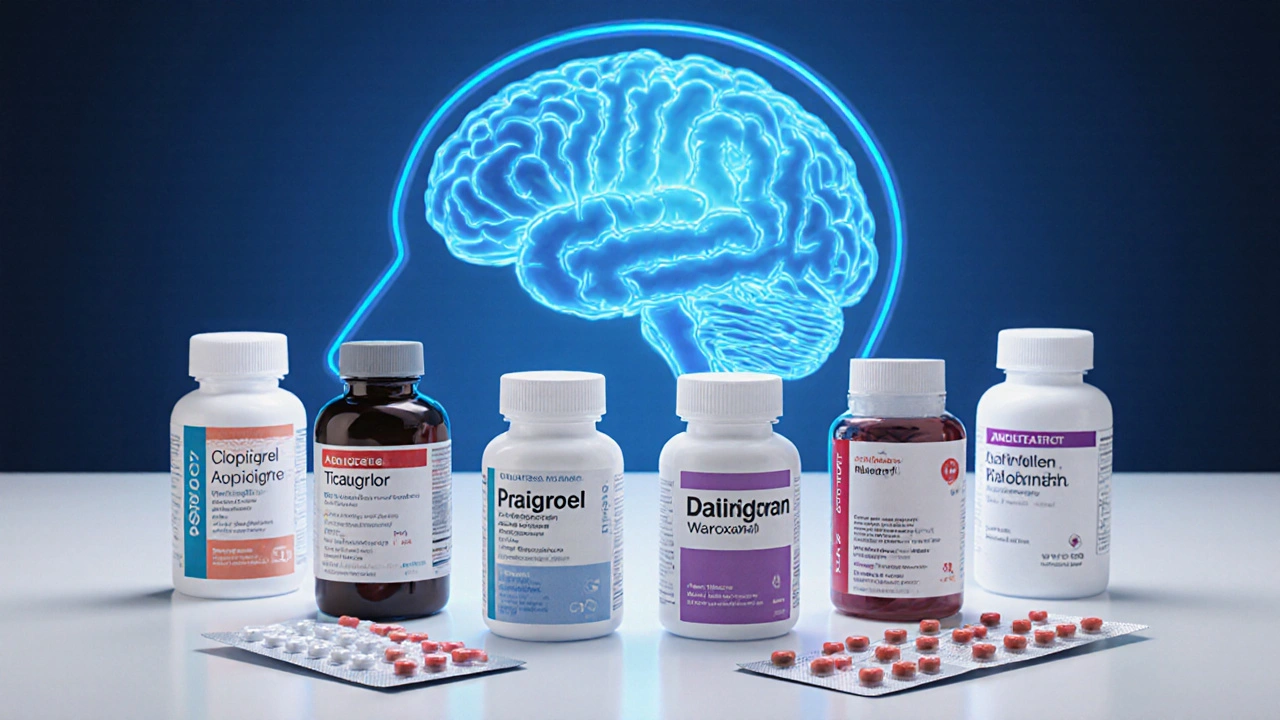Stroke Prevention Medication Comparison Tool
Comparison Results
About This Tool
This interactive tool compares key characteristics of stroke prevention medications including Aggrenox, clopidogrel, aspirin, ticagrelor, prasugrel, dabigatran, rivaroxaban, and warfarin. The comparison includes mechanism of action, bleeding risk, cost, and monitoring requirements.
Select two medications to compare their features. This information supports informed discussions with your healthcare provider about stroke prevention options.
Key Takeaways
- Aggrenox combines dipyridamole and aspirin to reduce recurrent stroke risk.
- Clopidogrel, ticagrelor, and prasugrel are potent antiplatelet alternatives with different bleeding profiles.
- Direct oral anticoagulants (DOACs) such as dabigatran and rivaroxaban are used when atrial fibrillation drives the clot risk.
- Cost, dosing convenience, and need for monitoring vary widely across options.
- Switching meds should involve a physician, especially when bleeding risk or drug interactions are a concern.
Understanding Aggrenox (Dipyridamole)
Aggrenox is a fixed‑dose combination of dipyridamole (200mg) and low‑dose aspirin (25mg) taken twice daily. It is approved for secondary prevention of non‑cardioembolic ischemic stroke and transient ischemic attack (TIA). Dipyridamole works by inhibiting platelet aggregation and dilating cerebral vessels, while aspirin irreversibly blocks thromboxane A2 production. Together they provide a synergistic antiplatelet effect that has been shown in trials like ESPS‑2 to lower recurrent stroke rates by about 20% compared with aspirin alone.
Why Look at Alternatives?
Not everyone tolerates dipyridamole’s side effects-headache, nausea, and flushing are common. Some patients need once‑daily dosing, or they have contraindications to aspirin (e.g., active peptic ulcer). In those cases clinicians consider other antiplatelet agents or even anticoagulants. Below are the most frequently discussed alternatives.

Other Antiplatelet and Anticoagulant Options
Clopidogrel is a thienopyridine that irreversibly inhibits the P2Y12 receptor on platelets. It is sold under the brand name Plavix and is taken once daily (75mg). It’s a common alternative for patients who cannot tolerate aspirin or dipyridamole.
Aspirin (acetylsalicylic acid) is the oldest antiplatelet drug. Low‑dose aspirin (81mg) taken daily blocks thromboxane A2, reducing clot formation. It remains a go‑to option for many because of its low cost and wide availability.
Ticagrelor (brand Brilinta) is a reversible P2Y12 inhibitor that provides faster platelet inhibition than clopidogrel. The typical dose for stroke prevention is 90mg twice daily.
Prasugrel (brand Effient) is another thienopyridine with more potent platelet inhibition than clopidogrel, used at 10mg once daily for patients under 75 without a history of stroke.
Dabigatran (Pradaxa) is a direct thrombin inhibitor classified as a direct oral anticoagulant (DOAC). It is taken twice daily (150mg) and is indicated for stroke prevention in atrial fibrillation, not for standard antiplatelet therapy.
Rivaroxaban (Xarelto) is a factor Xa inhibitor DOAC, administered once daily (20mg) for atrial fibrillation-related stroke prevention.
Warfarin (Coumadin) is a vitamin K antagonist that requires regular INR monitoring. It is less often used for primary stroke prevention today but remains an option for patients with mechanical heart valves or certain hypercoagulable states.
Side‑Effect Profiles at a Glance
- Aggrenox: headache, flushing, gastrointestinal upset; low major bleeding risk.
- Clopidogrel: mild bruising, rare severe bleeding; risk of resistance in CYP2C19 poor metabolizers.
- Aspirin: gastrointestinal irritation, ulcer risk, especially at higher doses.
- Ticagrelor: dyspnea, occasional bleeding, no need for metabolic activation.
- Prasugrel: higher bleeding risk, contraindicated in prior stroke/TIA.
- DOACs (dabigatran, rivaroxaban): lower intracranial bleed risk than warfarin, but can cause GI bleeding.
- Warfarin: frequent INR checks, diet‑drug interactions, higher intracranial bleed risk.
Comparison Table
| Drug | Class | Typical Dose for Stroke Prevention | Mechanism | Bleeding Risk | Cost (US$ per month) | Monitoring Needed? |
|---|---|---|---|---|---|---|
| Aggrenox | Antiplatelet (combo) | Dipyridamole 200mg + aspirin 25mg BID | Platelet inhibition + vasodilation | Low‑moderate | ≈$140 | No |
| Clopidogrel | Antiplatelet (P2Y12 inhibitor) | 75mg QD | Irreversible P2Y12 blockade | Moderate | ≈$30 | No |
| Aspirin | Antiplatelet (COX‑1 inhibitor) | 81mg QD | Irreversible COX‑1 inhibition | Low‑moderate | ≈$5 | No |
| Ticagrelor | Antiplatelet (reversible P2Y12) | 90mg BID | Reversible P2Y12 blockade | Moderate‑high | ≈$120 | No |
| Prasugrel | Antiplatelet (P2Y12 inhibitor) | 10mg QD | Irreversible P2Y12 blockade | High | ≈$150 | No |
| Dabigatran | Anticoagulant (direct thrombin) | 150mg BID | Direct thrombin inhibition | Moderate | ≈$350 | No routine labs |
| Rivaroxaban | Anticoagulant (factor Xa) | 20mg QD | Factor Xa inhibition | Moderate | ≈$320 | No routine labs |
| Warfarin | Anticoagulant (vitamin K antagonist) | Individualized (target INR 2‑3) | Blocks vitamin K-dependent clotting factors | High | ≈$15 | Yes (INR) |

Choosing the Right Option for You
Consider these practical questions when deciding between Aggrenox and its rivals:
- Do you experience frequent headaches or flushing after dipyridamole? If yes, a single‑agent like clopidogrel may be easier.
- Is cost a major factor? Aspirin and warfarin are the cheapest, but they may need additional meds to reach the same protection level.
- Do you have a history of gastrointestinal ulcers? Low‑dose aspirin alone can aggravate them; a P2Y12 inhibitor without aspirin might be safer.
- Are you on other drugs that affect CYP2C19 (e.g., proton‑pump inhibitors)? Clopidogrel’s efficacy can drop in poor metabolizers.
- Is you or a close family member on anticoagulation for atrial fibrillation? In that case a DOAC such as dabigatran could address both stroke risk and AF.
These criteria help clinicians match the medication to your personal risk profile.
How to Safely Switch from Aggrenox
Never stop a prescription on your own. A typical taper‑or‑switch plan looks like this:
- Consult your neurologist or primary‑care physician. They’ll assess bleeding risk and recent imaging.
- If moving to clopidogrel, the doctor may discontinue Aggrenox and start clopidogrel the next day. No overlap is usually needed.
- When switching to a DOAC, a short “bridge” with low‑dose aspirin may be used for 1-2 days to cover the gap in antithrombotic effect.
- Monitor for new symptoms-headache, bruising, or worsening neurological signs-and report them promptly.
- Schedule a follow‑up visit within 4‑6 weeks to verify the new regimen’s efficacy and tolerance.
Adhering to a guided transition reduces the chance of rebound clotting or excess bleeding.
Frequently Asked Questions
Can I take Aggrenox with a DOAC?
Generally no. Combining two antithrombotic agents dramatically raises bleeding risk. Your doctor might use a very low‑dose aspirin with a DOAC only in select high‑risk cases, but it’s not standard practice.
Why does dipyridamole cause flushing?
Dipyridamole dilates peripheral blood vessels, which can increase blood flow to the skin and trigger a warm, flushed sensation. Taking the dose with meals or splitting it into smaller portions can help.
Is clopidogrel as effective as Aggrenox for preventing stroke?
Large trials (e.g., CAPRIE) showed clopidogrel modestly reduces stroke risk compared with aspirin alone, but the combination in Aggrenox often yields a slightly better outcome for patients without aspirin intolerance. The choice depends on tolerance and individual risk factors.
Do I need regular blood tests while on Aggrenox?
No routine labs are required for Aggrenox because it’s an antiplatelet, not an anticoagulant. However, your doctor may check CBC or liver enzymes periodically if you have other health issues.
What should I do if I miss a dose of Aggrenox?
Take the missed dose as soon as you remember, unless it’s almost time for the next dose. In that case, skip the missed one and continue with your regular schedule. Do not double‑dose.
Bottom Line
Choosing between Aggrenox comparison and its alternatives isn’t a one‑size‑fits‑all decision. We’ve broken down the mechanisms, side‑effects, cost, and monitoring needs so you can have a fact‑based conversation with your healthcare provider. Whether you stay on the dipyridamole‑aspirin combo or switch to a newer P2Y12 blocker or a DOAC, the goal remains the same: keep your brain safe from another stroke.

